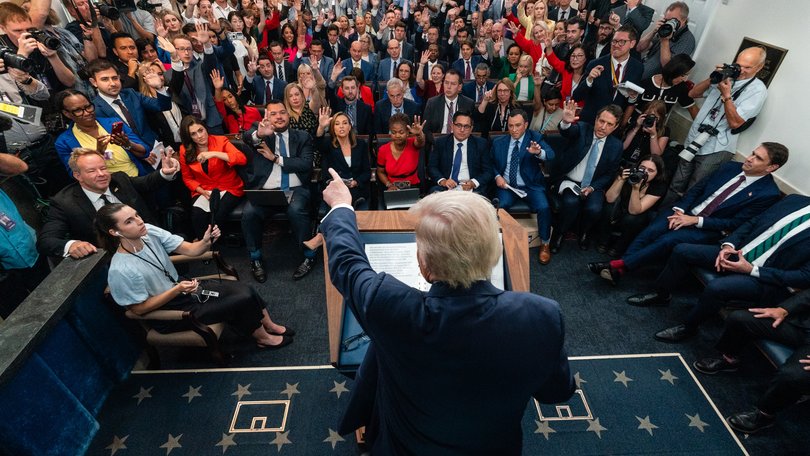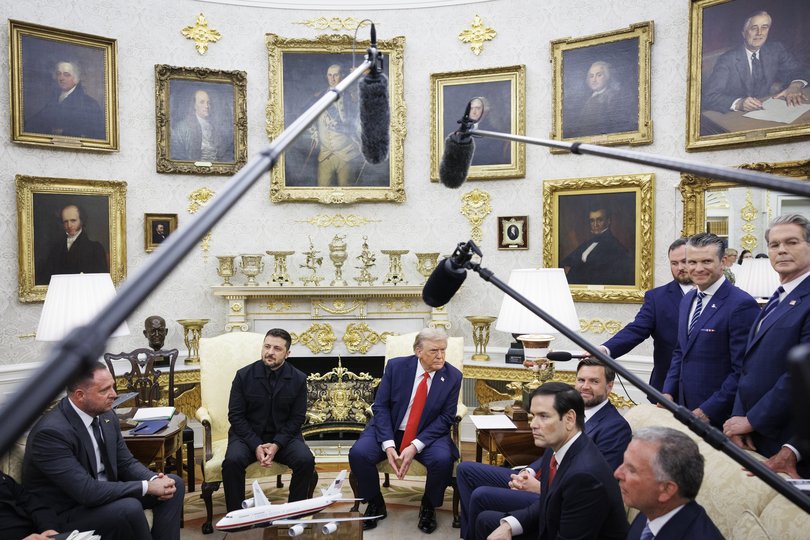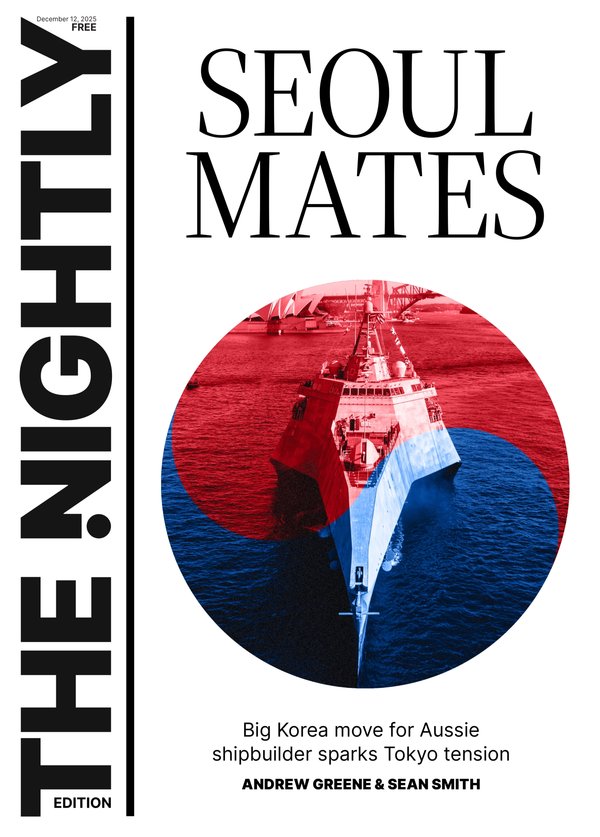For Donald Trump, media manipulation is his show of force

President Donald Trump has long railed against the “fake news” as an “enemy of the people.” But this week, the President showed how far he has come in finding a new use for the media: as props.
Friendly influencers were summoned to the White House on Wednesday afternoon, as they have been throughout Mr Trump’s second term, to bolster his agenda and attack his targets of the moment.
Reporters from mainstream news organisations remained part of the presentation, but mostly as silent foils and heels to be disparaged and critiqued.
Sign up to The Nightly's newsletters.
Get the first look at the digital newspaper, curated daily stories and breaking headlines delivered to your inbox.
By continuing you agree to our Terms and Privacy Policy.“I read more of your stories than I do theirs,” FBI Director Kash Patel told the influencers, gesturing to the reporters at the back of the room, “because you guys are putting out the truth.”
That televised interplay, made possible by the splintered media environment and Mr Trump’s knack for exploiting public mistrust, has allowed Mr Trump and his aides to manipulate public perceptions of the news in ways that their predecessors would not have attempted, or imagined.
Mr Trump has marshalled the levers of government to punish outlets and reporters he deems overly critical while finding ways to integrate a new genre of friendly reporters into curated presentations that have the look and feel of news — even if they essentially serve as extensions of his policy pitches.
This week’s example was among the most striking.
Just weeks after threatening to pull licenses from broadcast network stations whose late-night comedians he deemed overly critical of him, the President invited influencers friendly to his hard-line immigration policy to an event targeting antifa, a far-left decentralised global movement whose proponents oppose fascism, sometimes militantly.
The conservative influencers were part of the event, presented as putatively independent sources to tell their own stories and validate Mr Trump’s case that antifa is a domestic terror organisation whose associates should be prosecuted.
Mr Trump called them “courageous journalists” and described at least some as “victims of antifa attacks.” He quizzed them on which of the traditional news networks was “the worst” and then weighed in with his own list of grievances against the mainstream media.
The assembled influencers were set apart as the real truth-tellers. “They’re reporting the stories live time because the mainstream media won’t cover it,” Mr Patel said.
Some of them had accepted Department of Homeland Security Secretary Kristi Noem’s offer to embed with immigration raids and have recorded altercations with protesters objecting - sometimes aggressively - to the enforcement tactics.
“While public trust in the legacy media just plummeted to a new low, President Trump is giving a voice to independent journalists who actually care about uncovering and reporting the truth,” White House spokesperson Liz Huston said in a statement.
Highlighting those conservative new-media personalities to bolster his controversial immigration crackdown is the latest example of Mr Trump using creators to amplify his message.
In February, when Ukrainian President Volodymyr Zelensky visited the Oval Office in his usual military-style attire, Brian Glenn, the White House bureau chief for the right-wing outlet Real America’s Voice, helped set the stage for a shouting match between Mr Trump and Mr Zelensky.
“You’re at the highest level in this country’s office, and you refuse to wear a suit,” Mr Glenn told Mr Zelensky, “a lot of Americans have problems with you not respecting the dignity of this office.”
Mr Glenn did not respond to a request for comment.

The Administration also leaned on influencers in February as part of an early attempt to deliver a campaign promise to release records related to deceased sex offender Jeffrey Epstein.
Attorney General Pam Bondi invited right-wing content creators to the White House and handed them binders labeled “The Epstein Files: Phase 1.”
They posed for a photo, but the effort backfired when the binders were revealed to contain mostly old information, and the administration tried to limit the release of records.
Previous presidents, even those such as Ronald Reagan who was famous for aggressively shaping his public image, “knew that the press had a job to do, even if they didn’t like the reporters,” said Frank Sesno, a former White House bureau chief for CNN and a professor at George Washington University School of Media and Public Affairs.
Larry Speakes, a chief Reagan White House spokesman, had a sign on his desk that read: “You don’t tell us how to stage the news and we don’t tell you how to cover it.”
“That’s not how Donald Trump sees it,” said Sesno, who argued that Mr Trump wants to direct both the staging and the reporting of the news.
In late February, the White House took control of the press pool, a small, rotating group of news organizations that covers events on behalf of the larger press corps.
At the time, press secretary Karoline Leavitt said she wanted to break the traditional press’s “monopoly” allow more outlets to cover the president up close.
But the decision came on the heels of the White House denying the Associated Press access to White House events after the Associated Press declined to adopt “Gulf of America” to describe the Gulf of Mexico, as Mr Trump was demanding.
The White House later eliminated designated seats in the pool for wire services.
Those slots increasingly go to what the White House calls the mostly Trump-friendly “new media” journalists, including podcasters and individual influencers who focus on specific topic areas.
Now, every time the White House holds an official press briefing, the person in the new media seat gets the first question and a generous introduction from Ms Leavitt — a status that was traditionally reserved for the AP.
In return, the person often thanks her profusely for allowing them in the room.
The seat’s occupant is sometimes selected based on the policy the White House is discussing that day.
When Mr Trump signed an executive order aimed at banning trans women from competing in women’s sports, Sage Steele, a former ESPN journalist who has been critical of the practice and has since launched her own podcast, appeared in the photo op next to him.
Ms Steele did not respond to a message seeking comment.
“That question sets the entire frame for the entire briefing, and that would have never happened in a million years the first time around,” said Stephen K. Bannon, a former chief strategist in Mr Trump’s first term and an influential radio host.
“They reimagined the White House as a major information content provider; that’s the difference.”
The White House also has increasingly invited reporters from friendly outlets that have promoted conspiracy theories, such as One America News and Gateway Pundit, to join the press pool that follows the president, with Mr Trump prioritising their questions — and the reporters often lavishing Trump and his allies with praise.
“I am so thankful for each and every one of you here right now,” Mr Glenn, of Real America’s Voice, told the influencers on Wednesday, noting that several have appeared on his network.
“Even before he ran for office, Trump saw journalists as creatures of his own device,” said Steve Herman, a former White House bureau chief for Voice of America, which Mr Trump has sought to eliminate. He is now the executive director of the Jordan Centre for Journalism Advocacy and Innovation at the University of Mississippi.
“A good journalist is anyone who is helping to advance Trump’s agenda or agrees with his perceptions and prejudices.”
Cam Higby, an influencer who had worked with Peter Schweitzer to identify the groups allegedly funding antifa, posted a photo on X of the influencers at the antifa event at the White House on Wednesday with the caption: “The future of journalism is bright.”
Ms Leavitt reposted his message and wrote: “I am proud to work for a President who bucks the fake news establishment media and welcomes independent journalists with open arms. As long as President Trump’s in charge, new voices are always welcome in the People’s House.”
By Thursday evening, the White House released a highly produced video featuring the influencers who had attended the antifa event, interspersed with messages from Bondi, Patel and other administration officials.
- - -
Dan Diamond and Aaron Schaffer contributed to this report
© 2025 , The Washington Post
